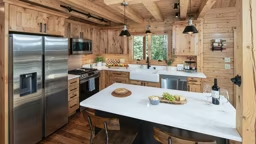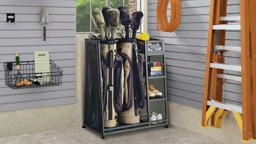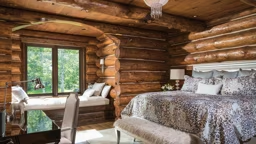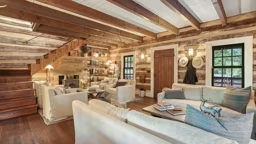
One of the first questions that occurs to people who contemplate buying a log home is "What kind of wood is the best to use?" There is no one correct answer to that question because quality log homes can be built successfully from many different wood species. Wood has many different characteristics. Which species is best often depends on which of these characteristics you consider to be the most important.
Characteristics of Wood Species
The characteristics of wood that generally concern log home buyers are appearance, resistance to decay, insulation value, cost and stability--that is, how much shrinking, twisting, warping and checking the wood is likely to experience over the years. Log home producers share consumers' concerns about these characteristics. They also have to take into account other factors when determining which wood to use. These additional considerations include the availability of the particular species in commercial quantities and the ease with which the wood can be cut and shaped into building logs. Given all the variables that affect the selection of wood species, you can understand why it is so difficult to single out one species as "the best." A good starting point in evaluating wood is to review the characteristics that both consumers and producers most frequently mention as important.
Appearance
The appearance of wood on the exterior of a log home will change with time due to the effects of weathering. Application of certain wood preservatives also can cause changes in the appearance of wood. The best wood for you in terms of appearance will depend solely on your personal taste.
Decay Resistance
Although the natural decay resistance of various species of wood differs considerably, most producers strongly recommend treating the exterior of log homes with a wood preservative, regardless of the wood's natural decay resistance. While natural decay resistance is definitely a plus, it should not unduly influence your choice of a particular wood species.
R-Value
The following listings provide the R-value of each species of wood. Note, however, that the difference between the species with the highest and lowest R-values is only fractional. As the section on [energy efficiency loghomes/engineering/energy.html] points out, R-value is only one consideration in evaluating the energy efficiency of a log home.
Stability
The tendency of a wood to shrink, twist, warp and check is a valid concern for both consumers and producers. Fortunately, it also is a factor that can be controlled by various producers through good materials-handling techniques. As an example, a wood that tends to shrink can be kiln-dried or air-dried, thus controlling this characteristic. Also, through careful grading of the wood, those logs with an inherent tendency to twist or warp can be identified and rejected. Therefore, the instability of a particular species can be overcome in many cases through good materials selection and management procedures.
Cost
The price paid for different wood species can be significant. Some wood, such as Northern white cedar, is expensive because it is a slow-growing species and is difficult to harvest in commercial quantities. Other wood, such as Southern yellow pine, is less expensive because it is a fast-growing species that is sufficiently available in commercial quantities in many of the Southeastern states. The following listing provides information on the basic characteristics of the wood species most often used for log homes. Also included are comments from the companies that offer different species as to the general suitability of the wood for use in a log home. This information will go a long way toward helping with the often difficult decision of which wood to select for your log home.
Here, some details on the 23 most common species to keep in mind:
Atlantic White Cedar Chamaecyparis thyloes
Common names: Juniper, Southern white cedar
Grown: Near the Atlantic Coast from Maine to northern Florida and westward along the Gulf Coast to Louisiana. Strictly a swamp tree.
Harvested: Primarily in North Carolina and along the Gulf Coast.
Characteristics: Heartwood is light brown and highly resistant to decay. Sapwood is white or close to white and usually thin. Lightweight, soft, low in strength and shock resistance. Shrinks very little. Easily worked and holds paint well.
Approximate R-value per inch: 1.41
Suitability: Generally considered one of the finer grades of wood, not as readily available as Northern white cedar.
Northern White Cedar Thuja occidentalis
Common names: Aborvitae, cedar.
Grown: From Maine along the Appalachian Mountain range and westward through the northern Great Lakes states.
Harvested: Primarily in Maine and the Great Lakes states.
Characteristics: Similar to Atlantic white cedar
Approximate R-value per inch: 1.41
Suitability: Generally considered by many producers as one of the finer grades of wood. A premium priced wood available only in smaller diameters in the East.
Western Red Cedar Thuja plicata
Common names: Aromatic, canoe, giant arborvitae, shinglewood, Pacific red cedar.
Grown: Pacific Northwest, along the Pacific Coast to Alaska.
Harvested: Primarily in Washington, Oregon, Idaho, Montana.
Characteristics: Heartwood is reddish or pinkish brown to dull brown, very resistant to decay. Sapwood is nearly white, usually not wider than one inch. Generally straight-grained, with uniform, rather coarse, texture. Shrinks very little. Lightweight, moderately soft. Low strength when used as a beam or post. Low shock resistance.
Approximate R-value per inch: 1.09
Suitability: Popular, even though sufficient quantities are difficult to obtain. It is a very attractive wood and very stable, although generally more expensive than other woods, especially in the Eastern United States.
Baldcypress (Red and Yellow) Taxodium distichum
Common names: Cypress, or Southern red, yellow or white cypress; commercially coast-grown cypresses called tidewater, red or gulf cypress; inland-grown cypresses called yellow cypress.
Grown: Southern and south Atlantic states.
Harvested: Same areas.
Characteristics: Sapwood narrow and nearly white. Heartwood varies widely in color, from light yellowish brown to chocolate. Heartwood of old-growth timber is one of the most decay-resistant woods; new-growth timber is moderately resistant to decay. Moderate in weight, strength and hardness. Shrinkage is moderately small, but somewhat greater than that of cedar, less than that of pine.
Approximate R-value per inch: 1.04
Suitability: Primarily used for extremely high decay-resistant qualities of the red or tidewater varie ties.
Douglas Fir Pseudotsuga menziesii
Common names: Red fir, Douglas spruce, yellow fir.
Grown: Pacific Coast to the Rocky Mountains, and from Mexico to central British Columbia.
Harvested: Oregon, Washington, California, Rocky Mountain states.
Characteristics: Sapwood narrow in old-growth trees; may be as much as 3 inches wide in second-growth trees. Varies widely in weight and strength depending on where harvested. Moderately decay resistant.
Approximate R-value per inch: 0.99
Suitability: A very strong wood. Beams cut from this species can span greater distances than many other woods. Also said to be less supportive of mildew and fungus than some other woods.
True Fir Abies balsamea, abies fraseri
Common names: Balsam fir, Fraser Fir.
Grown: Balsam fir in New England, New York, Pennsylvania, Great Lakes states; Fraser fir in Appalachian regions of Virginia, North Carolina, Tennessee.
Harvested: Same areas.
Characteristics: Heartwood and sapwood generally indistinguishable; wood creamy white to pale brown. Balsam fir light in weight, low in bending and compressive strength, moderately limber, soft, low in shock resistance. Low decay resistance.
Approximate R-value per inch: 1.27
Suitability: Generally not available in sufficient diameter for log home use.
True Fir (Western Species) Abies lasiocarpa, abies grandis, abies procera, abies amabilis, abies concolor
Common names: Subalpine fir, grand fir, noble fir, Pacific silver fir, white fir.
Grown: Washington, Oregon, California, western Montana, northern Idaho.
Harvested: Same areas.
Characteristics: Heartwood and sapwood generally indistinguishable; wood creamy white to pale brown. All light in weight. All but subalpine fir have higher strength than eastern species of true fir. Shrinkage rate small to moderate. Low decay resistance.
Approximate R-value per inch: 0.99
Suitability: Grows more slowly than some other firs, so has finer grain and is stronger. Less supportive of mildew, fungus than some other woods.
Eastern Hemlock Tsuga canadensis
Common names: Canadian hemlock, hemlock spruce
Grown: New England to northern Alabama and Georgia, Great Lakes states.
Harvested: New England, Mid-Atlantic states, Great Lakes states
Characteristics: Heartwood pale brown with reddish hue. Sapwood not distinctly separated from heartwood but may be lighter in color. Coarse, uneven in texture. Moderate in weight, limberness, hardness; moderately low in strength, shock resistance; low in decay resistance.
Approximate R-value per inch: 1.16
Suitability: Easy to pressure treat. More dimensionally stable, but more prone to wind shake damage. Doesn't tend to twist, bow or check.
Western Hemlock Tsuga heterophylla
Common names: West Coast hemlock, hemlock spruce, hemlock fir, Prince Albert fir, gray fir, silver fir, Alaska pine.
Grown: Pacific Coast of Oregon and Washington, from northern Rocky Mountains north to Canada and Alaska.
Harvested: Same areas.
Characteristics: Heartwood and sapwood almost white with a purplish tinge. Sapwood generally not more than 1-inch thick. Moderate in weight, strength, hardness, stiffness, shock resistance. Moderately high degree of shrinkage. Low decay resistance. Green lumber contains a considerable amount of moisture and requires longer kiln-drying time.
Approximate R-value per inch: 1.16
Suitability: Generally considered a more difficult wood to work with because of high degree of shrinkage.
Western Larch Larix occidentalis
Grown: Western Montana, northern Idaho, northeastern Oregon, eastern slope of the Cascade Mountains in Washington.
Harvested: Idaho, Montana, Oregon, Washington.
Characteristics: Heartwood yellowish brown. Sapwood yellowish white, not more than 1-inch thick. Moderate in stiffness, weight, strength, hardness, decay resistance; moderately high in shock resistance and shrinkage. Usually straight-grained. Splits easily. Subject to ring shake. Knots common but small and tight.
Approximate R-value per inch: 0.99
Suitability: Some consider it more difficult to machine.
Red Oak Quercus rubra
Common names: Northern oak (other species are seldom used in log homes).
Grown: Southern states, Southern mountain regions, Atlantic coastal plains, central states.
Harvested: Same areas.
Characteristics: Sapwood nearly white, usually 1 to 2 inches thick. Heartwood tan, or brown with tinge of red. Heavy, hard, tough. Some species may shrink considerably in drying. Low decay resistance.
Approximate R-value per inch: 0.79
Suitability: Generally difficult to acquire in sufficient quantities, when available it does produce a beautiful finish. Moderately expensive.
White Oak Quercus alba
Common names: White, chestnut, live oak (other species seldom used for log homes).
Grown: South Atlantic, central states, southern Appalachian region.
Harvested: Same areas.
Characteristics: Heartwood golden tan, or grayish brown. Heartwood has moderate to very high decay resistance. Sapwood nearly white, 1 to 2 inches thick. Heavy.
Approximate R-value per inch: 0.75
Suitability: Difficult to pressure treat. Expensive to kiln dry in timber sizes. Does provide beautiful finishes to a log home.
Eastern White Pine Pinus strobus
Common names: White pine, Northern white pine, Weymouth pine, soft pine.
Grown: Maine to northern Georgia, Great Lakes states.
Harvested: New England, Great Lakes states, Middle Atlantic and South Atlantic states.
Characteristics: Heartwood light brown, often with reddish tinge; turns darker on exposure. Comparatively uniform texture, straight-grained. Easily kiln dried, small shrinkage. High in stability. Easy to work. Lightweight. Moderately soft. Moderately low in strength, resistance to shock. Moderate decay resistance.
Approximate R-value per inch: 1.32
Suitability: Low shrinkage makes it a good building material. Has a high R-value. Stable wood. Difficult to find straight in long lengths. Seldom twists.
Lodgepole Pine Pinus contorta
Common names: Knotty pine, black pine, spruce pine, jack pine.
Grown: Rocky Mountain and Pacific Coast regions.
Harvested: Central Rocky Mountain states, Idaho, Montana, Oregon, Washington.
Characteristics: Heartwood varies from light yellow to light yellow brown. Sapwood yellow or nearly white. Generally straight-grained with narrow growth rings. Moderate in weight. Fairly easy to work. Moderately large shrinkage. Moderately low in strength, resistance to shock. Low decay resistance.
Approximate R-value per inch: 1.20
Suitability: Its shrinkage is generally half that of other pines. Can be found straight in long lengths.
Ponderosa Pine Pinus ponderosa
Common names: Western soft pine, California white pine, bull pine, blackjack pine, Jeffrey pine.
Grown: Oregon, Washington, California, Montana, Idaho, southern Rocky Mountains, Black Hills of South Dakota, Wyoming.
Harvested: Same areas.
Characteristics: Belongs to yellow pine group. Heartwood light reddish brown. Sapwood wide and nearly white to pale yellow. Moderate in weight, softness, stiffness. Moderately low in strength, shock resistance. Straight-grained, uniform texture. Moderately small shrinkage. Little tendency to warp or twist. Low resistance to decay.
Approximate R-value per inch: 1.16
Suitability: Works well in drier climates. Structurally stable.
Red Pine Pinus resinosa
Common names: Norway pine, hard pine, pitch pine.
Grown: Maine, Vermont, New Hampshire, Rhode Island, Connecticut, Massachusetts, Wisconsin, Michigan, Minnesota, Indiana, Ohio, Illinois, New York, Pennsylvania.
Harvested: Same areas.
Characteristics: Heartwood varies from pale red to reddish brown. Sapwood nearly white with yellowish tinge, 2 to 4 inches wide. Moderately heavy, strong, soft. Moderately high in shock resistance. Generally straight-grained, not as uniform in texture as Eastern white pine, somewhat resinous. Moderately large shrinkage. Not difficult to dry. Stays in place well when seasoned.
Approximate R-value per inch: 1.04
Suitability: Generally slightly more difficult to machine than other pines, but sufficiently available in commercial quantities.
Southern Yellow Pine Pinus palustris, pinus echinata, pinus taeda, pinus elliotti
Common names: Longleaf pine, shortleaf pine, loblolly pine, slash pine.
Grown: Southeastern New York and New Jersey to Florida, westward to eastern Texas and Oklahoma.
Harvested: Primarily Georgia, Alabama, North Carolina, Mississippi, Arkansas, Louisiana.
Characteristics: Sapwood yellowish white, usually very wide in second-growth stands, only 1 to 2 inches wide in old-growth trees. Heartwood reddish brown, begins to form when tree is 20 years old. Longleaf and slash pine wood heavy, strong, stiff, hard, moderately high in shock resistance. Shortleaf and loblolly usually lighter in weight. Moderately large shrinkage but stable when properly seasoned. All moderately decay resistant.
Approximate R-value per inch: 0.91
Suitability: A strong wood. Easy to pressure-treat and easy to kiln-dry. Tends to shrink, twist and warp more than other pines.
Western White Pine Pinus monticola
Common names: Idaho white pine.
Grown: Idaho, Washington, Montana, Oregon.
Harvested: Primarily in Idaho.
Characteristics: Heartwood cream colored to light reddish brown; darkens on exposure. Sapwood yellowish white, generally 1 to 3 inches wide. Straight-grained. Easy to work. Easily kiln-dried, stable after seasoning. Moderate in weight, softness, stiffness. Low in shock resistance. Moderately large shrinkage. Low decay resistance.
Approximate R-value per inch: 1.32
Suitability: Accepts wood treatments well. Stable, strong wood. Commercially available in large quantities so it is less expensive than some other pines.
Yellow Poplar Liriodendron tulipifera
Common names: Poplar, tulip poplar, tulipwood, hickory poplar.
Grown: Connecticut and New York, southward to Florida and westward to Missouri.
Harvested: South.
Characteristics: Sapwood white, several inches thick. Heartwood yellowish brown. Generally straight-grained, uniform in texture. Old-growth timber moderate in weight, softness; moderately low in bending strength; low shock resistance; moderately large shrinkage when dried, not difficult to season, stays in place well after seasoning. Second-growth timber heavier, harder, stronger than old-growth timber. Low decay resistance.
Approximate R-value per inch: 1.13
Suitability: Not generally available in commercial quantities.
Redwood Sequoia sempervirens
Common names: Coast redwood, California redwood, Sequoia.
Grown: California coast.
Harvested: California.
Characteristics: Heartwood varies from light cherry to dark mahogany, has high decay resistance. Sapwood narrow, almost white. Typical old-growth redwood moderately light in weight, strength, stiffness, hardness. Easy to work. Generally straight-grained. Shrinks and swells comparatively little.
Approximate R-value per inch: 1.0
Suitability: An expensive wood, high decay resistance, but tends to produce splinters.
Eastern Spruce Picea rubens, picea glauca, picea mariana
Common names: Red, white, black spruce.
Grown: Red in New England, Appalachians; white and black in Great Lakes states, New England.
Harvested: Same areas.
Characteristics: Wood light in color with little distinction between heartwood and sapwood. Moderate in weight, shrinkage, strength, stiffness, toughness, hardness. Easily worked. Dries easily, stable after drying. Low in decay resistance.
Approximate R-value per inch: 1.16
Suitability: Generally considered durable and easily machined. Not widely available in commercial quantities.
Englemann Spruce Picea englemanii
Common names: White, mountain, Arizona, silver spruce, balsam.
Grown: Higher elevations in the Rocky Mountains.
Harvested: Rocky Mountain states, Oregon.
Characteristics: Heartwood nearly white with slight tinge of red. Sapwood varies from 1 to 2 inches in width, often difficult to distinguish from heartwood. Medium to fine texture. Generally straight-grained, light in weight, low in strength as beam or post. Limber, soft, low in shock resistance. Moderately small shrinkage. Typically contains numerous small knots. Low in decay resistance.
Approximate R-value per inch: 0.99
Suitability: Stronger than some species of Western pine. Black Walnut Juglans nigra Common names: American black walnut.
Grown: Vermont to the Great Plains, southward into Louisiana and Texas.
Harvested: Primarily in the central states.
Characteristics: Heartwood varies from light to dark brown. Sapwood nearly white, up to 3 inches wide in open-grown trees. Normally straight-grained. Easily worked, stable in use. Heavy, hard, strong, stiff. Good resistance to shock. High decay resistance. Approximate R-value per inch: Not available.
Suitability: Difficult to pressure-treat. Expensive to kiln-dry in timber sizes. Can make a beautiful finish for a log home. --Most of this information was derived from the Wood Handbook: Wood As an Engineering Material, published by the U.S. Department of Agriculture.











